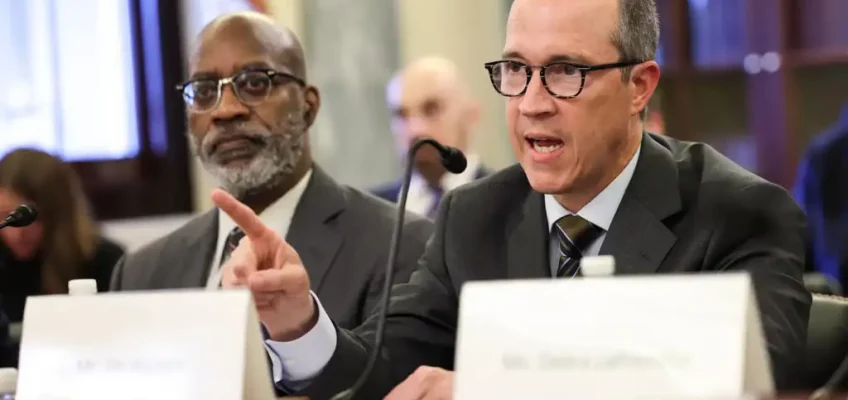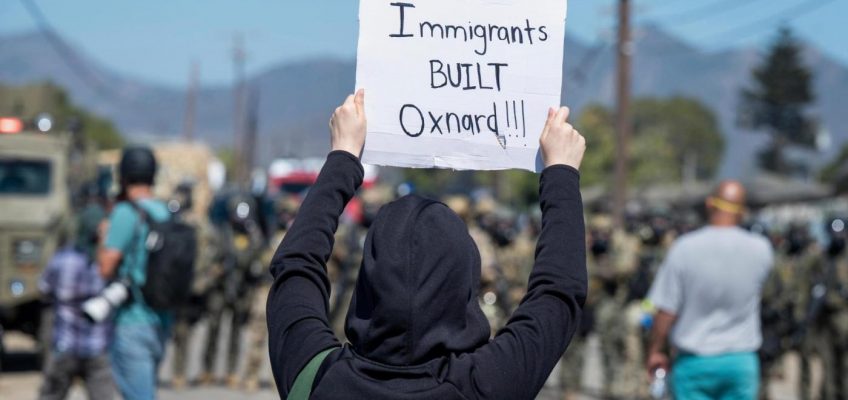By JULIE WATSON, AMY TAXIN and OLGA R. RODRIGUEZ, Associated Press
Federal authorities now say they arrested more than 360 people at two Southern California marijuana farms last week, characterizing the raids as one of the largest operations since President Donald Trump took office in January.
One farmworker died after falling from a greenhouse roof during the chaotic raids on Thursday after the Department of Homeland Security executed criminal search warrants at Glass House Farms facilities in Camarillo and Carpinteria, northwest of Los Angeles.
The raids came more than a month into an extended crackdown across Southern California that was originally centered on Los Angeles, where local officials say the federal actions are spreading fear in immigrant communities. A federal judge on Friday ordered the Trump administration to halt indiscriminate immigration stops and arrests in seven California counties, including Los Angeles.
What happened?
During the raid on the Camarillo site, crowds gathered seeking information about their relatives and to protest immigration enforcement. Authorities clad in military-style helmets and uniforms faced off with the demonstrators, and people ultimately retreated amid acrid green and white billowing smoke.
Glass House Brands is a major cannabis company in California that started a decade ago with a greenhouse in the Santa Barbara County community of Carpinteria.
Federal immigration agents talk to Rebecca Torres, second left, after she tried to block a military vehicle during a raid in the agriculture area of Camarillo, Calif., Thursday, July 10, 2025. (AP Photo/Michael Owen Baker)
The company said it later expanded, buying another facility in the Ventura County community of Camarillo that included six tomato and cucumber-growing greenhouses. Glass House converted two of them to grow cannabis, according to the company’s website.
Relatives of workers at the Camarillo site said tomatoes are still grown at the location in addition to cannabis.
Arrest numbers keep rising
The federal government initially reported that some 200 people suspected of being in the country illegally were arrested.
Then on Saturday, Homeland Security Secretary Kristi Noem said 319 people were arrested and said on X it was “quickly becoming one of the largest operations since President Trump took office.”
Milk is poured on a protester’s face after federal immigration agents tossed tear gas at protesters during a raid in the agriculture area of Camarillo, Calif., Thursday, July 10, 2025. (AP Photo/Michael Owen Baker)
A day later, the arrest numbers, according to the Department of Homeland Security, were up to 361 from the two locations.
The government said four of the 361 arrested had prior criminal records, including convictions for rape and kidnapping.
One death reported from the raids
A farmworker who fell from a greenhouse roof during the raid at the farm in Camarillo died Saturday of his injuries.
Jaime Alanis, 57, is the first known fatality during one of the Trump administration’s ongoing immigration enforcement operations. Yesenia Duran, Alanis’ niece, confirmed his death to The Associated Press.
She posted on the fundraising site GoFundMe that her uncle was his family’s only provider and he had been sending his earnings back to a wife and daughter in Mexico. Alanis worked at the farm for 10 years, his family said.
He called his wife in Mexico and told her he was hiding from federal agents during the raid Thursday. A doctor told his relatives that the ambulance crew who took him to a hospital said he fell about 30 feet, Duran said.
US imposes a 17% duty on fresh Mexican tomatoes
Trump administration says it won’t publish major climate change report on NASA website as promised
How Trump plans to dismantle the Education Department after Supreme Court ruling
MAGA faithful are angry about the Epstein case. Here’s what to know.
Supreme Court allows Trump to lay off nearly 1,400 Education Department employees
Why was the business raided?
The government says it is investigating potential child labor, human trafficking and other abuse. Initially, DHS said 10 immigrant children were on the property. They later increased that number to 14.
Authorities declined to share the warrant for the operation. The administration has released no additional information about the children, including their ages and what they were doing on the property when authorities arrived. DHS has not provided details to back up its claim of possible trafficking or other abuse, and the company has not been charged with anything.
It was unclear if any of the minors were the children of farm workers at the sites or if they came to the U.S. without an adult.
Federal and state laws allow children as young as 12 to work in agriculture under certain conditions, according to the U.S. Department of Labor. In California, children as young as 12 can work on farms outside of school hours, while those as young as 16 can work during school hours if they are not required to attend school, the agency said on its website.
No one under the age of 21 is allowed to work in the cannabis industry.
The California Department of Cannabis Control conducted a site visit in May 2025 and observed no minors on the premises, a spokesperson said. After receiving a subsequent complaint, the state opened an investigation to ensure full compliance with state law.
U.S. citizens were among those arrested
Four U.S. citizens were arrested during the raids for allegedly “assaulting or resisting officers,” according to DHS, and authorities were offering a $50,000 reward for information leading to the arrest of a person suspected of firing a gun at federal agents.
Among those arrested was California State University Channel Islands professor Jonathan Caravello, U.S. Attorney Bill Essayli posted on X.
Essayli said Caravello was arrested for throwing a tear gas canister at law enforcement and was to appear in court Tuesday.
The California Faculty Association said Caravello was taken away by agents who did not identify themselves nor inform him of why he was being arrested. The association said he was then held without being able to contact his family.
Caravello was attempting to dislodge a tear gas canister that was stuck underneath someone’s wheelchair, witnesses told KABC-TV, the ABC affiliate in Los Angeles.
Separately, the federal Bureau of Prisons said George Retes, 25, was in their custody at the Metropolitan Detention Center in downtown Los Angeles from Thursday to Sunday.
Retes’ family told KABC-TV on Sunday that he is a U.S. citizen, works as a security guard at the farm in Camarillo and is a disabled U.S. Army veteran. They said Retes was trying to drive away during the clashes between protesters and agents when an officer stopped him, broke his car window and shot pepper spray before dragging him out of his car and arresting him.
Retes’ sister, Destinee Magaña, told the television station on Sunday that the family had been trying to get in touch with her brother.
Federal agents “thought he was probably part of the protest, but he wasn’t, he was trying to reverse his car,” Magaña said.
Neither Retes nor Magaña responded to emails Monday from The Associated Press seeking comment.
The region prepares for more raids
Los Angeles Mayor Karen Bass is now proposing to provide cash assistance to residents too scared to leave their homes to go to work.
The plan comes as part of a sweeping executive order the mayor signed on Friday that instructs Los Angeles officials “to bolster their protocols and training to prepare for federal immigration activity occurring on city property.”
The order also establishes a police department working group for immigrants and expands access to resources for impacted families. In addition, it seeks records from the federal government on what the city deems unlawful raids from federal agencies.
The monetary relief will not come from city funds but from philanthropic partners, officials said. Immigrant rights groups will distribute cash cards similar to those used to provide financial assistance to Angelenos struggling during the COVID-19 pandemic. It wasn’t immediately clear how people will qualify to receive the cards.
The goal is to help people who have been deterred “from attending school and church, seeking city services, accessing health care, and going to work,” the order states.
Associated Press writer Christopher Weber in Los Angeles contributed to this report.



